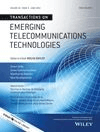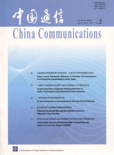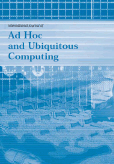
Transactions on Emerging Telecommunications Technologies
Scope & Guideline
Exploring Breakthroughs in Global Telecommunications
Introduction
Aims and Scopes
- Emerging Telecommunications Technologies:
The journal emphasizes the exploration and analysis of new technologies that are shaping the future of telecommunications, including 5G, 6G, IoT, and beyond. - Network Security and Privacy:
A strong focus on the security aspects of telecommunication networks, including intrusion detection systems, secure communication protocols, and privacy-preserving techniques. - Machine Learning and AI in Telecommunications:
Research on the application of machine learning and artificial intelligence techniques to improve network performance, security, and resource allocation. - Resource Management and Optimization:
Studies that propose innovative algorithms and methodologies for efficient resource allocation, task scheduling, and network management in various telecommunication environments. - IoT and Smart Systems:
Research related to the Internet of Things (IoT), including its integration with telecommunications for smart city applications, healthcare, and industrial automation. - Wireless Communication and Signal Processing:
Innovative approaches and methodologies in wireless communications, including MIMO, OFDM, and advanced signal processing techniques for better transmission and reception. - Blockchain Technology in Telecommunications:
Investigation of blockchain applications in telecommunications for enhancing security, data integrity, and decentralized communication protocols.
Trending and Emerging
- 6G and Beyond:
Research focusing on the next generation of wireless networks, including 6G, is gaining traction as researchers explore new paradigms and technologies that will define future telecommunications. - Artificial Intelligence and Machine Learning Applications:
The application of AI and machine learning in telecommunications is rapidly growing, with studies focused on enhancing network performance, security, and user experience. - Cybersecurity in Telecommunications:
With the increasing threats to network security, research has intensified around cybersecurity measures, intrusion detection, and secure communication protocols. - Edge Computing and IoT Integration:
The integration of edge computing with IoT systems is a prominent theme, emphasizing low-latency processing and efficient data management in real-time applications. - Quantum Computing and Secure Communications:
An emerging area of interest is the exploration of quantum computing's implications for secure communications, including quantum key distribution and quantum-safe algorithms. - Smart Cities and Urban Networks:
Research focusing on telecommunications solutions for smart cities, including infrastructure, resource management, and service delivery optimization, is increasingly significant. - Blockchain Applications in Telecommunications:
The exploration of blockchain technology for enhancing security, transparency, and efficiency in telecommunications systems is becoming a vital area of research.
Declining or Waning
- Traditional Networking Protocols:
Research on older networking protocols is becoming less prominent as newer, more efficient protocols are developed, making way for innovative architectures. - Legacy Systems Integration:
Studies focusing on the integration of legacy systems with modern networks have decreased as industries move towards adopting entirely new systems and technologies. - Basic Communication Theories:
While foundational theories remain important, the journal has seen a decline in publications focused solely on basic communication theories, favoring more applied research. - Conventional Hardware Solutions:
Research on traditional hardware implementations is waning as the industry shifts towards software-defined networking (SDN) and virtualized solutions. - Static Network Architectures:
The exploration of static network architectures is declining as there is a growing emphasis on dynamic, adaptive network designs that can better accommodate changing demands.
Similar Journals

Journal of Information and Telecommunication
Pioneering Research in the Heart of Digital Communication.Journal of Information and Telecommunication, published by TAYLOR & FRANCIS LTD, is a distinguished open access journal that has been enhancing the global discourse since its establishment in 2017. With an ISSN of 2475-1839 and an E-ISSN of 2475-1847, this journal is located in the United Kingdom and dedicates its focus to the fields of information technology, telecommunications, and related disciplines. Boasting a respectable Q2 quartile ranking across various categories including Computer Networks and Communications, Electrical and Electronic Engineering, and Computer Science Applications in 2023, it ranks notably in the top percentiles of scopus rankings, asserting its significance in the academic community. The journal's commitment to open access since its inception has fostered widespread accessibility, encouraging research dissemination and collaboration on a global scale. By providing a platform for high-quality research, it aims to unite researchers, professionals, and students in their pursuit of innovation and excellence in the ever-evolving digital landscape.

Telecom
Fostering Global Knowledge Exchange in TelecommunicationsTelecom is an esteemed peer-reviewed journal published by MDPI, specializing in the fields of computer networks and communications as well as electrical and electronic engineering. Since its inception in 2020, this Open Access journal has provided a platform for innovative research and advancements in telecommunication technologies, making significant contributions to both academia and industry. With an impressive impact factor and a category rank of Q2 in the 2023 Scopus rankings, Telecom continues to be a valuable resource for researchers, professionals, and students seeking to engage with cutting-edge developments in telecommunication. The journal invites high-quality manuscripts that explore emerging trends, challenges, and solutions in the ever-evolving telecom landscape. Situated in Basel, Switzerland, Telecom is committed to fostering a global exchange of knowledge and serves as an essential conduit for advancing the discourse in telecommunications.

China Communications
Exploring the Latest Trends in China's Communication LandscapeChina Communications is a prestigious peer-reviewed journal published by the China Institute of Communications, dedicated to advancing the field of telecommunications and information technology. With an impressive Q1 ranking in both Computer Networks and Communications and Electrical and Electronic Engineering, this journal stands out as a leading source of cutting-edge research and innovative solutions in the engineering domain. The journal aims to provide a platform for scholars and practitioners to share their findings on the latest trends, technologies, and methodologies impacting the communications landscape in China and beyond. It is particularly noted for its high visibility in the academic community, as demonstrated by its Scopus rankings, which place it in the top percentiles for both fields. Through its commitment to quality content, China Communications contributes significantly to the advancement of knowledge, making it an invaluable resource for researchers, professionals, and students alike.

Journal of Electronics & Information Technology
Shaping the Future of Electronic EngineeringJournal of Electronics & Information Technology, published by the prestigious Chinese Academy of Sciences, Institute of Electronics, stands as a vital resource in the field of Electrical and Electronic Engineering. With an ISSN of 1009-5896, this journal has been dedicated to the dissemination of advanced research and innovative applications since its inception in 2001. It holds a competitive position within its category, ranked Q3 in the 2023 Scopus database, reflecting its contribution to the scientific community. The journal addresses a wide array of topics related to electronics and information technology, making it indispensable for researchers, professionals, and students aiming to stay at the forefront of technological advancements. Although it operates under a traditional model of access, its cumulative output remains pivotal for knowledge sharing and innovation in the rapidly evolving landscape of electronic engineering. With its commitment to excellence, the Journal of Electronics & Information Technology aims to foster a thriving academic environment and promote impactful research within the discipline.

Journal of Grid Computing
Exploring the Future of High-Performance ComputingThe Journal of Grid Computing, published by Springer, stands as a pivotal resource in the dynamic field of computer science, particularly within the realms of Computer Networks and Communications, Hardware and Architecture, Information Systems, and Software. With an impressive Q1 ranking across these categories in 2023, the journal exemplifies excellence and rigor, catering to a diverse readership from researchers to industry professionals. Established in 2003, this esteemed journal is anchored in the Netherlands and releases cutting-edge research that reflects trends and advancements in grid computing technologies. Researchers can gain insights through its vast contributions, while institutions benefit from its prestigious standing within the SCOPUS framework, boasting high percentile ranks in multiple computer science categories. Though not open access, the journal provides unparalleled access options for institutional subscribers, solidifying its importance as a gateway to innovative discoveries in high-performance distributed computing.

International Arab Journal of Information Technology
Advancing Knowledge in Information TechnologyWelcome to the International Arab Journal of Information Technology, a prestigious publication under the aegis of ZARKA PRIVATE UNIVERSITY in Jordan, dedicated to advancing the field of Information Technology. First established in 2008, this journal has made significant strides in disseminating high-quality research, achieving an impressive Q2 ranking in Computer Science (miscellaneous) and securing a notable 57th percentile position in the Scopus rankings. With a comprehensive scope encompassing various sub-disciplines of computer science, the journal is committed to promoting scholarly dialogue and innovation among researchers, professionals, and students. While currently operating as a subscription-only journal, it remains a vital resource for the academic community seeking to explore the latest trends and advancements in technology. The International Arab Journal of Information Technology is not only a platform for original research but also a vibrant hub for ideas that shape the technological landscape of the Arab region and beyond.

Frontiers in Communications and Networks
Empowering Scholars to Shape the Future of ConnectivityFrontiers in Communications and Networks is a prominent open-access journal published by FRONTIERS MEDIA SA, established in 2020 and positioned in the heart of Switzerland. As an interdisciplinary platform, it focuses on advancing research related to computer networks, communications, and signal processing, providing a critical forum for innovative findings and developments in these rapidly evolving fields. With an impressive Q1 ranking in Computer Networks and Communications and a Q2 ranking in Signal Processing as of 2023, this journal is highly regarded among scholars and practitioners seeking to disseminate their work to a broad audience. By offering open-access options, it ensures that the research is widely available, fostering collaboration and knowledge sharing across the globe. Researchers, professionals, and students are encouraged to engage with the journal as it aims to encapsulate the burgeoning advancements shaping our digital communication landscape.

International Journal of Electronics and Telecommunications
Exploring the Future of Electronics and NetworksWelcome to the International Journal of Electronics and Telecommunications, a prominent publication dedicated to the evolving fields of electronics, telecommunications, and computer networks. Established by the Polska Akademia Nauk (Polish Academy of Sciences), this journal is committed to fostering academic research and technological advancements within these crucial domains. As of 2023, it holds a Q4 ranking in both Computer Networks and Communications and Electrical and Electronic Engineering, showcasing its role as a platform for emerging ideas and groundbreaking studies. With an Open Access model implemented since 2013, it enhances the visibility and accessibility of its articles, encouraging a broader impact and collaboration among researchers, professionals, and students alike. The journal serves as an important resource for those interested in the intersection of technology and communications, and it continues to contribute to the academic dialogue surrounding these vital sectors.

International Journal of Ad Hoc and Ubiquitous Computing
Unraveling the Future of Ubiquitous TechnologyThe International Journal of Ad Hoc and Ubiquitous Computing, published by InderScience Enterprises Ltd, is a premier platform dedicated to advancing the fields of computer networks, communication systems, hardware, and software architecture. Since its inception in 2005, this journal has served as a critical resource for researchers, professionals, and students aiming to explore the intricate dynamics of ubiquitous computing and ad hoc networks. Though currently not an open-access journal, its scholarly contributions are well-recognized, as evidenced by its rank in the Scopus database, which places it within the lower quartiles of its respective categories. With an increasing focus on innovative solutions in computer science, the journal aims to facilitate knowledge dissemination and encourage interdisciplinary collaborations. Researchers are particularly drawn to the journal for its comprehensive coverage of emerging technologies, making it an invaluable asset in a world increasingly reliant on sophisticated communication infrastructures. As it continues to thrive towards 2024, the journal remains committed to fostering a vibrant academic community.

ELECTRONICS LETTERS
Unleashing the Potential of Electronics Innovations.ELECTRONICS LETTERS, published by WILEY, is a leading peer-reviewed journal dedicated to the field of Electrical and Electronic Engineering. With a rich history dating back to 1965, this journal serves as a prominent platform for disseminating novel research and innovations in electronics, covering topics such as circuit design, telecommunications, and signal processing. In 2021, the journal transitioned to an Open Access format, ensuring that cutting-edge research is freely accessible to a global audience, thereby enhancing its impact and outreach. The journal currently holds a Q3 quartile ranking in its category, reflecting its solid position among its peers, and ranks #451 out of 797 in Scopus for Electrical and Electronic Engineering, placing it within the 43rd percentile. ELECTRONICS LETTERS is essential for researchers, professionals, and students looking to stay abreast of the latest developments and contribute to advancements in the field, fostering collaboration and knowledge sharing in a rapidly evolving landscape.